The introduction of the Heavenly Horse to China
by Wang Zhenshan and Jessica Eile-Keith
More than 2000 years ago, there was a breed of horses so superior and grand that they caused a war, by historians named the first war ever fought over horses. This horse is today called Akhal-Teke and is still bred to perfection by Central Asian nomads.
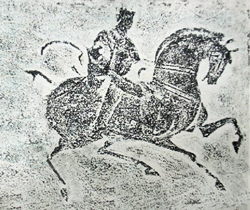 Rubbing from a stone relief found in China dated to the Han period.
This horse display all traits of a modern Teke.
Dry, noble head with a slight roman nose,
long, hight and free set neck with a clear neck bend,
strong, well defined shoulders,
long and strong back,
well muscled croup.
The horse also carries the rider in a well balanced and smooth manner.
Rubbing from a stone relief found in China dated to the Han period.
This horse display all traits of a modern Teke.
Dry, noble head with a slight roman nose,
long, hight and free set neck with a clear neck bend,
strong, well defined shoulders,
long and strong back,
well muscled croup.
The horse also carries the rider in a well balanced and smooth manner. |
The first horse selectively bred for speed and size
The history of the Akhal-Teke horse is as fascinating as its magnificent impression.
The founders of the fastest and most beautiful horse of the Central Asian steppes, the nomads, left no written sources from their life with the magnificent, golden steeds.
The remnants of the first Indo-Scythian nomads who breed these horses to perfection are to be found in burial mounds in Central Asia, the worship of the horse are as obvious as the fact the their taming the horse and selecting for speed and size made them feared enemies among the neighbor countries and hostile tribes.
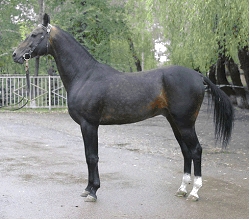 The modern Teke stallion Murgab one of the best examples of the breed today display, the noble head, long, high and free set neck, stong well defined shoulders, long strong back, well muslced croup and long, dry legs.
The modern Teke stallion Murgab one of the best examples of the breed today display, the noble head, long, high and free set neck, stong well defined shoulders, long strong back, well muslced croup and long, dry legs. |
Han dynasty emperor finds the Central Asian elite horse
The Chinese Emperor Wu-ti (reigned at 141 B.C. – 87B.C.) of the Han dynasty was a true horseman. Many times he had heard about the extraordinary elite horses kept by various Indo-Scythian tribes in what is now called Central Asia.
The Hsiung-nu (the Huns), Turko-Mongol nomads had been considered a threat to the recently united China since the end of the third century B.C.
The Great Wall was completed in 215 B.C in order to protect China from the bloodthirsty Hsiung-nu, who drank their slain enemy’s blood from their skulls.
Equally gruesome habits were practiced by the Indo-European nomads such as the Scythians who drank blood from the first enemy he had killed.
The Han emperor (the Son of Heaven) Wu-ti, planned to battle the Hsiung-nu and drive them away from the Chinese borders. He wanted an ally in the nomads Ta Yueh-chih. The Ta Yeuh-chih, called the Tokhari by the Greeks had emigrated from Turkestan to Ta-hsia (Bactria) in the second century B.C. Later during the Roman period the same nomadic tribe was called Indo-Scythians.
Wu-ti sent his ambassador Chang Ch’ien to negotiate an alliance with the Ta Yueh-chih.
Chang Ch’ien was captured by the Hsiung-nu and held in custody for 10 years before he could continue his mission.
However, neither the Yueh-chih that he visited in 128 B.C in Sogdiana, the country north of Oxus (Amy Darya), with the capital Kienshih (Samarkand) nor the king of Ta-yuan (Fergana) had an interest in fighting the Hsiung-nu."
The ambassador returned to his emperor, on his way back he was again taken into custody by the Hsiung-nu for a year before he could finally meet his emperor again.
Some of the horses he had seen in Fergana, Ta-yuan horses, had left him with an unforgettable impression though. He reported that in Fergana there were good horses that sweated blood and were said to be sons of the Heavenly Horse.
Emperor Wu-ti became attached to the tall and powerful Ta-yuan horses, the blood sweaters. These elite horses were in much need to conquer the eternal enemy, the Hsiung-nu.
Wu-ti had to fight the Hsiung-nu by himself but maintained friendly relationships with Ta-yuan (Fergana).
The first war about horses in the history is fought in 104 B.C.
Around the year of 104 B.C., the appointed Chinese ambassador, Che Ling, was killed as the Ferganese did not want to give away their superior horses they considered the treasure of their country.
In 104 B.C. the Chinese army under general Li Kuang-li attacked the Ta-yuan to get hold of the superior Ta-yuan horses. The army lost the battle and had to return without horses.
Historians have named this event the first war to obtain horses.
In 102 B.C. sixty thousand men under general Li Kuang-li marched towards Fergana in what by historians is called the second war to obtain horses. Arriving with only thirty thousand men left he managed to close off the water supply to the capital.
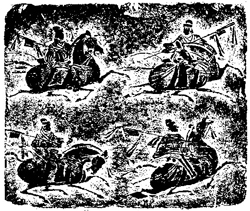
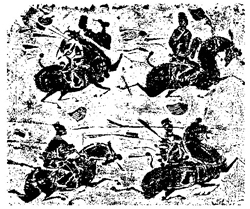 Rubbings from stone reliefs found in China dated to the Eastern Han Dynasty 25 A.D. - 220 A.D.
The Tekes are sometimes described to move like snakes and look like dragons, these Heavenly horses really move like Tekes.
The free and balanced form under rider is also visible.
Rubbings from stone reliefs found in China dated to the Eastern Han Dynasty 25 A.D. - 220 A.D.
The Tekes are sometimes described to move like snakes and look like dragons, these Heavenly horses really move like Tekes.
The free and balanced form under rider is also visible. |
Finally the Ferganese gave up and offered the Chinese army, according to the records several tens of elite horses and 3 000 medium and below medium level horses.
When general Li Kuang-li returned he had ten thousand men left and only 1 000 of the 3 000 horses had survived the long road to China.
The Heavenly Horse is named
Wu-ti was very impressed by the Ta-yuan horses, he found them more beautiful and strong than the horses he had obtained from the Wu Sun nomads and named the heavenly horses.
The horses earlier obtained from the Wu-sun nomads were now named Xi Ji Ma (horses of the extreme west).
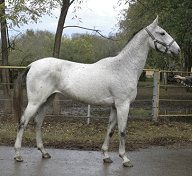 The Teke mare Prokhlada displays the slight roman nose that is a trait in some Tekes
The Teke mare Prokhlada displays the slight roman nose that is a trait in some Tekes |
The Wu-sun (Alans) tribe was probably located in the regions of modern Kazakhstan. They are described by Chinese historians as people with red beard and blue eyes. The Wu-sun believed that they became horses in their second life.
The emperor’s hymn to the Heavenly Horse
The Ta-yuan horses, the Fergana horses were now given the name of the Heavenly horse (Tian Ma)
and the following poem was dedicated to these steeds by emperor Wu-ti:
Hymn To the Heavenly Horse
The Heavenly Horse has come to the earth from the west,
It covers tens of thousands of Li [1] to subordinate itself to the virtuous Emperor,
Incarnate the divine prowess,
It holds the foreign enemy in submission,
Crossing the sands,
It convinces the barbarians of its power.
With the horses came the special forage
The Ferganese had promised the Han emperor to annually give him two heavenly horses.
Together with these horses came the alfalfa, a protein rich legume originating from Fergana that these horses loved to eat.
The Heavenly horse has returned to the Middle Kingdom
Today alfalfa is grown in many parts of China and thanks to recent imports from Central Asian countries, the Heavenly horse has returned to the Middle Kingdom.
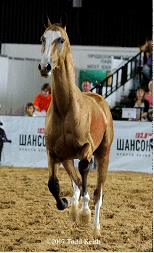 One of the Heavenly Horses that was recently imported into China.
One of the Heavenly Horses that was recently imported into China. |
There are today eight pure bred Akhal-Tekes in China and considering the great interest for this cultural treasure there will soon be more.
Note:
[1] li: a unit for measuring length in China. In Han dynasty, one li = 415.8 metres.
Key references
[1] Lin Ying. Celestial horses. Beijing, Foreign Language press, 2002
[2] Sima Qian. (145-90B.C.) The Records of the Grand Historian.
[3] Rene Grousset. The Empire of the Steppes. Rutgers University Press 1970.
[4] Ban Gu (32 – 92 A.D.) Book of Han.
|